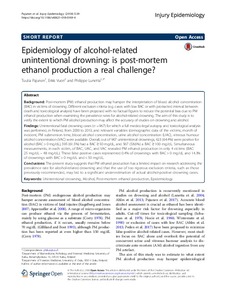Epidemiology of alcohol-related unintentional drowning: is post-mortem ethanol production a real challenge?
Pajunen T.; Vuori E.; Lunetta P.
https://urn.fi/URN:NBN:fi-fe2021042826408
Tiivistelmä
Background
Post-mortem (PM) ethanol production may hamper the interpretation of blood alcohol concentration (BAC) in victims of drowning. Different exclusion criteria (e.g. cases with low BAC or with protracted interval between death and toxicological analysis) have been proposed with no factual figures to reduce the potential bias due to PM ethanol production when examining the prevalence rates for alcohol-related drowning. The aim of this study is to verify the extent to which PM alcohol production may affect the accuracy of studies on drowning and alcohol.
Findings
Unintentional fatal drowning cases (n = 967) for which a full medico-legal autopsy and toxicological analysis was performed, in Finland, from 2000 to 2013, and relevant variables (demographic data of the victims, month of incident, PM submersion time, blood alcohol concentration, urine alcohol concentration (UAC), vitreous humour alcohol concentration (VAC) were available. Overall, out of 967 unintentional drownings, 623 (64.4%) were positive for alcohol (BAC > 0 mg/dL), 595 (61.5%) had a BAC ≥ 50 mg/dL, and 567 (58.6%) a BAC ≥ 100 mg/dL. Simultaneous measurements, in each victim, of BAC, UAC, and VAC revealed PM ethanol production in only 4 victims (BAC: 25 mg/dL – 48 mg/dL). These false positive cases represented 0.4% of drownings with BAC > 0 mg/dL and 14.3% of drownings with BAC > 0 mg/dL and < 50 mg/dL.
Conclusions
The present study suggests that PM ethanol production has a limited impact on research addressing the prevalence rate for alcohol-related drowning and that the use of too rigorous exclusion criteria, such as those previously recommended, may led to a significant underestimation of actual alcohol-positive drowning cases.
Kokoelmat
- Rinnakkaistallenteet [27094]
